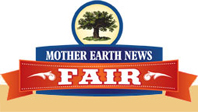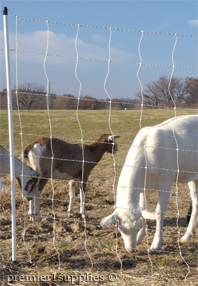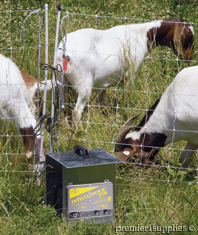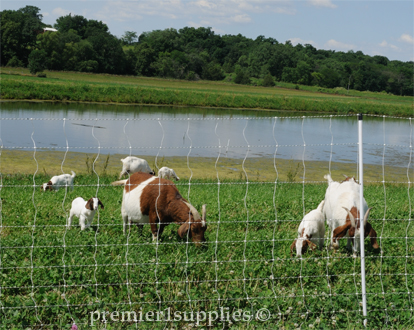MOTHER EARTH NEWS FAIR
 Visit us at
Visit us at
Mother Earth News Fair
Premier's booth #1570 & 1571
Puyallup, WA
May 31 - June 1, 2014
Premier's booth #151 & 153
Seven Springs, PA
September 12-14, 2014
Premier's booth -- TBA
Topeka, KS
October 25-26, 2014
ELECTRIC NETTING

A few dairy type goats enjoying some late season grazing. The netting used is PermaNet 10/48/6.
PermaNet® 10/48/6
| • |
10 horizontal strands (9 energized) |
| • |
48" tall installed. |
| • |
String verticals every 6" |
| • |
Line posts (built-in) every 12.5 ft. |
| • |
Post diameter is 0.75" dia. |
| • |
Post spikes: (SS) – 0.31" dia. and 8" long; (DS)– 0.31" dia and 7" long |
To purchase PermaNet…
| 1. |
Measure the fence line. |
| 2. |
Choose the length and the amount of netting needed. Example: For a 170 ft fence line, order a 150 ft net and a 25 ft net.
|
| 3. |
Choose support posts—
6 ft steel T posts driven 18" deep are advised for the ends or use 48" FiberTuff 22 posts at any corners. |
| 4. |
Select an energizer, ground rod and a fence tester. |
| 5. |
If you have questions—Call us toll free 1-800-282-6631. |
| 6. |
Free Shipping—If qualified order exceeds $100. |
View all of our
fencing for goats.
PREMIER ENERGIZERS

A 77B energizer mounted on an energizer support box. A solar panel can also be used.
Premier Energizers
| 1. |
110v AC (plug-in)—Energy input is 110v AC. Mount inside buildings or in a protected area outdoors. Connected to ground rods and fence with insulated wires. |
| 2. |
AC/DC—Can either be connected to a 12v battery or plugged directly into a 110v AC outlet.
|
| 3. |
DC (battery)—Input energy is from a 6 or 12 volt DC deep-cycle battery. |
| 4. |
Solar—Consists of a solar panel that’s directly attached to a case which, in turn, encloses a DC energizer and battery. |
Contact Premier or call 800-282-6631 to speak with one of our fence consultants to help you determine the best energizer for your needs.
You can also view our energizer comparison charts online or in Premier's fencing catalog for help in choosing an energizer.
|
 |
 |

Some of our Boer nannies grazing with their kids behind PermaNet® 10/48/6.
Kidding with dairy and meat goats
We're expecting our nannies to start kidding within the next few weeks. This means we're catering to their every whim and are putting up with their goatish behavior (clamoring and climbing on everything in the barn).
If you've already kidded (or like us have yet to kid) there are several articles below on raising meat and dairy goat kids successfully. We've found some useful information in them and hope that you do as well.
SUCCESSFUL DAIRY GOAT KID PRACTICES
Raising Dairy Goat Kids
Jolene Berg, Department of Animal Science, UC Davis
Peter Robinson, UC Cooperative Extension Specialist,
Department of Animal Science, UC Davis
Deborah Giraud, UCCE Farm Advisor, Humboldt County
Anyone who has worked with dairy goat kids knows that raising them, especially on a commercial scale, can be a challenging yet gratifying endeavor. Kids are the replacement animals that keep a herd at optimum production. It takes a lot of work and careful attention to produce a hard-working dairy goat from one of these bouncing babies. In this publication we have taken special care to include information compiled from published literature as well as practical advice from experienced commercial herders who follow these methods.
This is not meant to be a complete reference on raising kids on a commercial scale, but rather a sharing of successful practices used by commercial producers. Also, if you are looking into starting or acquiring a commercial-scale dairy goat operation, this publication will give you a general sense of the practices involved so you can make more educated decision as to whether this is the right business for you. For more detailed information, we encourage you to consult the publications listed under References and Resources and to visit as many commercial goat operations as you can before you actually start your own operation.
READ MORE »
GROWTH AND PERFORMANCE
Growth and Performance of Meat Goat Kids from Two Seasons of Birth in Kentucky. 1,2
K. M. Andries
1 Kentucky State University, Frankfort Kentucky, 40601
Corresponding author: kenneth.andries@kysu.edu
2 This article is part of Project KYX-60-05-14R, “Evaluation of doe and kid production and economic differences between fall and spring kidding season in meat goats.” Kentucky State University Experiment Station number KYSU-000015.
3 The author would like to acknowledge the assistance of the staff at the Kentucky State University Research and Demonstration Farm, director of the Land Grant Program, and Assistant Research Director
Summary
Little information is available on the impact of season of kidding on growth and performance of meat-goat kids. However, seasonal market trends have many producers in the southeastern United States kidding in the late fall and winter, when animals must be supplemented to meet nutritional needs. Because of this, a study was designed with the objectives being to evaluate the effect of season of birth and other factors on kid survival to weaning and performance from birth to weaning in meat-goat kids. One hundred and twenty commercial-meat-type does were used in this study. The does were bred for kidding either in the fall (October, November, and December) or spring (March, April, and May) seasons.
READ MORE »
STARTING GOAT KIDS OFF RIGHT
Colostrum Management for the Dairy Goat Kid
Jennifer Bentley, Dairy Field Specialist,
Iowa State University Extension and Outreach
Feeding kids the correct amount of high-quality colostrum immediately after birth is one of the most important management practices in kid management. Colostrum is so important that sometimes it is called “liquid gold”.
The Importance of Colostrum
All mammals produce colostrum. It is the thick, yellowish, first milk produced by the female after she gives birth. Colostrum is rich in energy, protein, vitamins, and minerals. Most importantly, it contains maternal antibodies that help protect the newborn from disease pathogens during the early part of its life. Immediately after birth, kids are exposed to a variety of infectious agents present in the environment, the doe, and other goats. Without any protection from these infectious organisms, the kids may become diseased and die.
At birth, the kid does not carry any antibodies against these organisms because antibodies in the doe’s bloodstream do not cross the placenta. However, these antibodies are concentrated in the colostrum and provide a natural and efficient source of protection against many intestinal, respiratory, and other diseases.
Vaccinating for diseases such as enterotoxemia and tetanus prior to kidding is important, since antibodies against these diseases will then be contained in the colostrum. Additionally, colostrum provides the energy needed to stay warm and acts as a laxative to ensure excretion of meconium.
Three Keys to Colostrum Feeding
To achieve the desired effects of colostrum, kid managers should focus on three factors: timing of feeding, the quantity fed and colostrum quality.
READ MORE »
KIDDING SUPPLIES
Lamb 'n' Kid
Feeding Bottle
An excellent plastic bottle specially designed for the rigors of lamb and kid feeding. Supplied with Pritchard Teat. Also use with our Bottle Rack.
View all of
Premier's Kidding Supplies.
Other Premier products we recommend and use with our new kids:
Advance™ Milk Replacer
Fully formulated complete feed for goat kids. It provides the entire nutritional requirements of the kid goat from its second day of life through to weaning.
GOAT HEALTH
Common Diseases and Health Problems in Sheep and Goats
Lynn Pezzanite, Animal Sciences Student, Purdue University
Dr. Michael Neary, Extension Small Ruminant Specialist, Purdue University
Terry Hutchens, Extension Goat Specialist, University of Kentucky
Dr. Patty Scharko, Extension Veterinarian, University of Kentucky
A sound management program to keep animals healthy is basic to production of both sheep and goats. Producers must observe animals closely to keep individual animals and the whole herd or flock healthy and productive. If the health status of a herd is compromised, that operation will not be as efficient as possible.
There are some human health risks when dealing with diseased animals. While most diseases affecting sheep and goats do not pose any human health risks, some are zoonotic and it is important to protect not only caretakers, but anyone else that may come in contact with diseased animals.
Sheep and goats share many health problems. While there are some important differences between the species, this publication gives a broad overview of diseases and health problems. For further information on specific diseases, references and sources of additional information are available at the end of this document.
READ MORE »
|
|